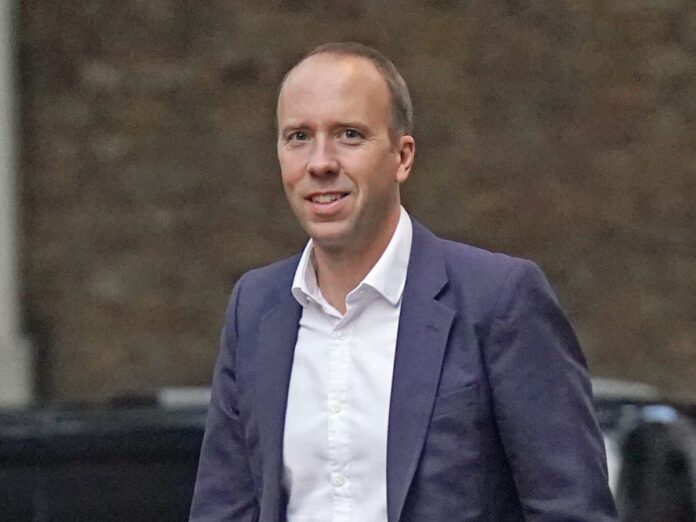Matt Hancock has defended his decision to appear on ITV’s I’m A Celebrity…Get Me Out Of Here!after he was suspended as a Coservative MP.The former health secretary said he hopes to use the platform of reality TV to raise awareness of dyslexia and the importance of an early diagnosis.Writing in The Sun, Hancock reflected on how his own late diagnosis after he left school aged 18 impacted him throughout his teenage years.’Far too many people in Britain don’t find out they’re dyslexic until they’ve left school, and tragically don’t get the support they need,’ Hancock said.’My diagnosis was a lightbulb moment and after many years of thinking I just wasn’t very good at reading, I finally understood why I didn’t always understand.’But what exactly is dyslexia, and what can you do if you suspect you or someone you know may have the condition?Here’s everything you need to know. According to the NHS, dyslexia is a learning difficulty that can cause problems with reading, writing and spelling. However, the British Dyslexia Association (BDA) states that the condition can affect people in other ways, including coordination, organisation and memory. They argue that claiming dyslexia only affects a person’s ability to read or write is a misconception, saying ‘if this were true, it would be much easier to identify’. The BDA says that dyslexia can manifest in many different ways, and that each individual will experience the condition in a way that is unique to them. As such, each person will have their own set of abilities and challenges. However, unlike a learning disability, a person’s intelligence isn’t affected by dyslexia. It’s estimated up to one in every 10 people in the UK has some degree of dyslexia.While symptoms often become more obvious when a child starts school, individuals can go through their entire life without realising that they have the condition, making the need to speak up and seek help if struggling more vital than ever.According to the BDA, dyslexia can manifest in different ways depending on a person’s age. For children aged four and under, the following indicators may suggest that a child has a Specific Learning Difficulty (SpLD) such as dyslexia. These include:Difficulty learning nursery rhymesLikes listening to stories, but shows no interest in letters or wordsDifficulty learning to sing or recite the alphabetDifficulty paying attention, sitting still or listening to storiesA history of slow speech developmentMuddles words, eg cubumber, flutterbyConfusion between directional words, eg up/downThe BDA notes that many young children display these behaviours and that the severity and length of time they persist provide clues to identifying dyslexia.Parents or carers worried about a child’s speech or language development are advised to speak with their GP, health visitor or Special Educational Needs Coordinator (SENCo) in your child’s early years setting. ‘Early help is vital to reduce the chance of loss of confidence and low self-esteem,’ they add. For primary school-aged children, general signs to look out for including poor concentration, forgetting words, difficulties following instructions and a reduced processing speed, eg slow spoken or written language. According to the BDA, a child can only be diagnosed with dyslexia through a Diagnostic Assessment, but these are usually only carried out from seven years old and are not needed to access support. Some signs to look for in secondary school-aged children include:A poor standard of written work compared with oral abilityPoor handwriting with badly formed letters, or neat handwriting, but writes very slowlyProducing badly set out or messy written work, with spellings crossed out several timesSpelling the same word differently in one piece of workDifficulty with punctuation and/or grammarConfusing upper and lower case lettersFailure to recognise familiar words when readingIs hesitant and laboured, especially when reading aloudOmits, repeats or adds extra words when readingReading at a reasonable rate, but with a low level of comprehensionDifficulty remembering tables and/or basic number setsFinding sequencing problematicConfusing signs, such as ‘x’ for ‘+’Being disorganised or forgetful eg over sports equipment, lessons, homework, appointmentsBeing immature and/or clumsySigns to look out for in adults include:Confusing visually similar words such as cat and cotErratic spellingFinding it hard to scan or skim textReading/writing slowlyA need to re-read paragraphs to understand themFinding it hard to listen and maintain focusFinding it hard to concentrate if there are distractionsA sense of mental overload/switching offThe BDA also features a series of age-appropriate checklists for dyslexia on their website, but is keen to state that such checklists cannot tell you if someone is dyslexic: ‘It is a tool used to help understand whether there is a likelihood of dyslexia, and whether further investigation should take place. Dyslexia can only be diagnosed through a formal Diagnostic Assessment.’In educational settings, teaching assistants, occasional one-to-one teaching or lessons in a small group with a specialist teacher may be possible. Technology, such as speech recognition software and electronic organisers, may also assist with day-to-day life as a person gets older. In the workplace, employers are required by law to make reasonable adjustments to help people with dyslexia, such as allowing extra time for certain tasks. Celebrities with dyslexia include Jennifer Aniston, Cher, Tom Cruise, Whoopi Goldberg, Orlando Bloom, Richard Branson, Keira Knightley, Jim Carrey, Holly Willoughby, Steven Spielberg and Jamie Oliver. Princess Beatrice, who was identified as having dyslexia at the age of seven, previously talked about the condition as a ‘gift’.As part of her aim to change the narrative around the condition, the 33-year-old, whose husband Edoardo Mapelli Mozzi is also dyslexic, said it ‘has been the making of some of my best decision making’.She said: ‘As an older person looking back, it definitely has allowed me to look at things in a new way and come up with solutions. ‘I always describe it like being able to think in a circle.’The British Dyslexic Society (BDA) offers information, advice, support and even a helpline for people wanting to know more about dyslexia. You can find out more information on their website.


